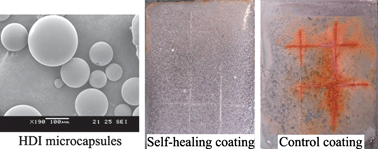Facile microencapsulation of HDI for self-healing anticorrosion coatings
Abstract
Polyurethane (

* Corresponding authors
a
School of Mechanical and Aerospace Engineering, Nanyang Technological University, Singapore
E-mail:
mjlyang@ntu.edu.sg
Fax: +65 6792 4062
Tel: +65 6790 6906
Polyurethane (

 Please wait while we load your content...
Something went wrong. Try again?
Please wait while we load your content...
Something went wrong. Try again?
M. Huang and J. Yang, J. Mater. Chem., 2011, 21, 11123 DOI: 10.1039/C1JM10794A
To request permission to reproduce material from this article, please go to the Copyright Clearance Center request page.
If you are an author contributing to an RSC publication, you do not need to request permission provided correct acknowledgement is given.
If you are the author of this article, you do not need to request permission to reproduce figures and diagrams provided correct acknowledgement is given. If you want to reproduce the whole article in a third-party publication (excluding your thesis/dissertation for which permission is not required) please go to the Copyright Clearance Center request page.
Read more about how to correctly acknowledge RSC content.
 Fetching data from CrossRef.
Fetching data from CrossRef.
This may take some time to load.
Loading related content
